|
DOI: 10.7256/2454-0676.2022.4.37411
EDN: MGXLYQ
Received:
26-01-2022
Published:
30-12-2022
Abstract:
The article deals with the main aspects of schoolchildren's reading in order to form a new approach in the field of motivation to read in the conditions of modern FGOS. The object of the study was the reading culture and motivation for reading of students from grades 5 to 11. The main research methods were questionnaires and analysis of the results obtained. The analysis of the survey results allowed us to establish the following: reading retains its importance and relevance for the younger generation. At the same time, it is necessary to note a number of important trends that are of great importance in the context of studying the processes of formation of motivation to read Among the identified trends: changes in the frequency and duration of reading, changes in genre preferences towards mass literature, the tendency of respondents to study works in short or adapted versions, the limitation of extracurricular reading to works subjectively interesting to schoolchildren. One of the key problems of the study was the question of the sincerity of the respondents. The results of the study can be applied in the process of literary education of schoolchildren in the formation of internal motivation to read. In addition, the presented questionnaire model can be used to form a reading environment in specific educational conditions, both in the above and in a modified form.
Keywords:
reading, questionnaire, methodology, education, literature study, reading environment, reading skills, reading motivation, Federal State Educational Standards (FSES), reading competencies
This article is automatically translated.
You can find original text of the article here.
The end of the XX — beginning of the XXI centuries are characterized by a number of negative processes for Russian education. In particular, a number of researchers, federal mass media and media resources persistently note a drop in interest in reading among the younger generation [3, p. 12]. Against the background of the development of digital infrastructure and almost unlimited access to information, there is a decrease in the motivation of students to study literature on the school curriculum and classical works of art. Nevertheless, it is impossible to say that reading has completely "gone out of fashion" among young people. But the approach of children and adolescents to the assimilation of information through the book has changed [8]. In this regard, the authors of the article consider it necessary to find out what, how and why schoolchildren read. The data of the survey conducted by us will allow us to initiate the development of a new approach to the formation of motivation to read, as well as to adjust the processes of studying literature in basic general education in the conditions of modern Federal State Educational Standard. The authors of the article suggest that in order for a student to develop reading skills and competencies, it is necessary to create a "reading environment" at school — a system of methodological conditions, which will primarily be based on the creation of a set of motivational practices, mechanisms for monitoring the progress of student readers and monitoring the success of students [10]. The instrument of the research search at the stage of the ascertaining experiment was the survey, which was conducted on the basis of 19 educational institutions of the city of Ulyanovsk and the region, including gymnasiums No. 1, No. 33, No. 34, the Mariinsky Gymnasium, schools ¹72, ¹31, ¹46, ¹58, Lyceums No. 11 and No. 38, Gubernatorial Lyceum No. 100, University Lyceum of the city of Dimitrovgrad, university classes at UlSPU, secondary school in the village of Alexandrovka, Shumovskaya secondary school, as well as Novomalyklinskaya secondary school, Bolshenagatkinskaya secondary school, Novoselkovskaya secondary school and Polivanovskaya secondary school. The purpose of the survey is to determine the needs of schoolchildren in reading, their motivation to read, interests and the level of reading literacy. A total of 499 people took part in the survey. The questionnaire begins with questions that give an idea of the demographic composition of respondents: their age, class of study and gender. Thanks to these questions, the analysis of the sample allows us to obtain data on the degree of formation of the reader's culture at a particular stage of training. We found that 270 respondents were female, 229 were male. The age range of respondents is from 10 to 18 years, that is, they are students of grades 5-11. The geography of the survey also becomes significant for the analysis. Of the 19 educational institutions, 7 are located outside the regional center. We have noted a small but alarming drop (by 9%) in the level of interest of rural school students in reading. The third question is "Do you like to read?" – allows you to identify the respondents' attitude to reading in general. In the future, these data will make it possible to think through and organize the reading environment more effectively, based on the identified literary preferences in children of a particular age. The subsequent survey will allow you to compare the level of children's enthusiasm for reading before the start of the training experiment and after. The answers to this question were distributed as follows: the answer "Yes" was given by 355 (67.1%) respondents, the answer "No" was given by 164 (32.9%) respondents. In addition, an age correlation was revealed: the leaders in "love" for reading were high school students from 15 to 18 years old (grades 9-11). Interestingly, it was the 9th grade students who also became the leaders of anti-rating – in terms of the number of "no" answers to the question "Do you like to read?". This sample once again confirms that high school students, as representatives of the most conscious age group, are more often interested in reading on their own initiative, that is, in this case, internal motivation is manifested, which L.S. Vygotsky repeatedly writes about in his works [4, p. 258]. At the same time, the overwhelming number of secondary school students find themselves in the zone of low motivation to read. For example, grade 9, a transitional stage both in terms of psychological and age characteristics, and in terms of the situation in the educational process, requires the closest attention and painstaking work from the literature teacher, which confirms the conclusions of G.G. Vinogradova [2, p. 65]. The fourth question – "How often do you read?" – is aimed at determining the frequency of students' access to literature. This will make it possible to conduct a training experiment more effectively and subsequently determine the effectiveness of the reading environment. The results of the survey on this issue were distributed as follows (see diagram No. 1): most often, 146 schoolchildren (29.3%) read once a week; 144 respondents (28.9%) are assigned to read 2-3 times a week, 138 respondents (27.7%) are taken to read less than once a week and, Finally, only 71 students (14.2%) read every day. 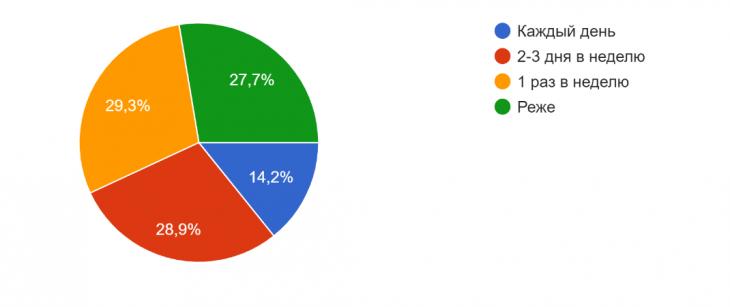
diagram No. 1 Naturally, it is necessary to find out the reasons for such a heterogeneous, ragged picture of children's reading. The analysis of the answers to the next, fifth question of the questionnaire helps us to solve this problem – "How long do you read if you are not in a hurry?". He reveals the peculiarities of the students' reading culture, their attentiveness and patience. The answers were distributed as follows (see diagram No. 2): the overwhelming number — 233 respondents — can stand reading for only an hour and a half a day; 102 students (20.4%) read no more than half an hour; 98 respondents (19.6%) spend 2-3 hours with a book and only 66 respondents (13.2%) they can't tear themselves away from reading for several hours. 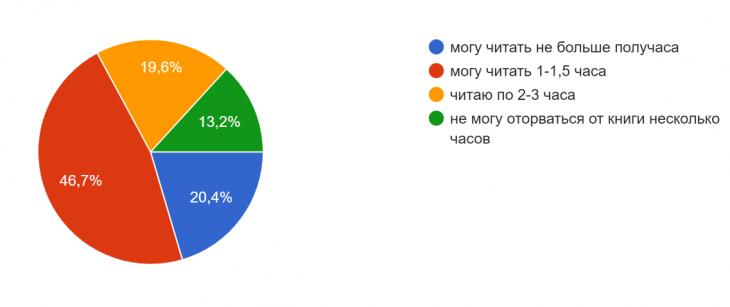
Diagram No. 2 Based on the results of the analysis of this sample, an alarming trend has been revealed that leaves no doubt: young people devote very little time to reading. According to the website briefly.ru , F. M. Dostoevsky's novel "Crime and Punishment" can be read on average in 16 hours [6], that is, almost half of the students will spend about two weeks reading the work. In these conditions, there is a vicious practice of familiarization with the brief content. Catastrophically many respondents (20.4%) admit that they cannot read for more than half an hour — this indicates a complete separation of students from the reading process and a lack of motivation for this type of activity, which allows us to set ourselves the task of developing special practices for the formation of a sustained interest in reading. The analysis of the data obtained on the fourth and fifth questions allows the authors of the article to assume that children tend to read, but they cannot always do it. In our opinion, the reasons for this problem are as follows: - the lack or absence of a reader's culture and internal stable motivation to read – that is, motivation, according to M. Armstrong, is not related to external circumstances, but to the very content of the activity [1, p. 348]; - lack of time caused by the volume of academic and extracurricular activities. Both reasons are confirmed by the children themselves, who have repeatedly left notes on the questionnaire sheets, wanting to go beyond the survey and share their own experiences and views in a broader form. So, a student of the 11th grade next to this question signed: "I would like to read more, but because of the exams there is no time at all." And if the second reason is purely objective and does not depend much on the students, then the first one requires special attention of the teacher. In this situation, a special role is assigned to the organization of the reading environment, which will allow for unobtrusive monitoring of students' progress, offer them reader competition through the Success Center – a key element of the reading environment, which is an interactive presentation associated with a cloud service, showing students' progress in reading in real time. This will allow you to convert external educational motivation into internal motivation, as well as put students in the place of creators and artists. [7, p. 245] The sixth question – "Do you like to listen to audiobooks?" – is aimed at identifying the potential volume among all respondents who are inclined to auditory perception. The information received will serve as a basis for specific elements of the reading environment. According to the data received, opinions were divided almost equally. Nevertheless, the majority — 273 respondents (54.7%) — do not like to perceive works of art in audio format. At the same time, 225 people (45.3%) regularly listen to audiobooks and rate this method of obtaining information as appropriate. It should be noted that this data will be much more useful on the basis of a specific class or classes. After conducting such a survey, a literature teacher can use such an element of the reading environment as the "Audiobook Library", which will meet the modern principles of information catalogs: constant ranking and updating, compiling the TOP 10 favorite books of the class (these same principles will form the basis of another key element of the reading environment: the "Classroom Library"). The seventh question is "On which medium is it most convenient for you to read?" – expands the data of the authors of the study on the perception of respondents, and also allows you to determine whether relatively new reading formats prevail over traditional ones. Based on these results, it is possible to identify the dominant elements of the reading environment. 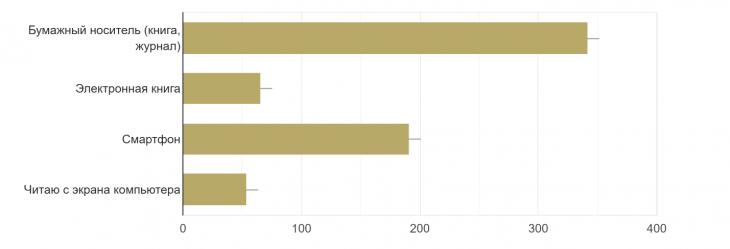
Diagram No. 3 The closed type of question was adjusted by the ability to select several options at once. This made it possible to make the selection the most detailed and complete. Respondents answered as follows (see diagram No. 3): 342 people (68.5%) chose paper media as the most convenient, 191 respondents (38.3%) noted a smartphone as a convenient option for reading, an e—book was in the third most popular place - 66 respondents (13.2%) chose it, and finally, 54 students (10.8%) found it convenient to read from a computer screen. Consequently, students choose various forms of reading, which is also important to take into account in the learning process. The eighth question – "List your most favorite books" – gives primary ideas about the preferences of schoolchildren, allows them to highlight their dominant, lays the foundations for a "Classroom library", which is part of the structure of the reading environment. The ninth question – "What book are you reading now?" – is distinguished by its simplicity and, at the same time, multitasking: firstly, it complements the data obtained on the basis of the eighth question; secondly, it allows you to determine whether children follow the school curriculum, and if not, how far from the proposed Finally, this question makes it possible to determine the individual reading level of the child, his involvement in school or extracurricular literature. The tenth question – "What genres of books do you like?" – expands the researcher's knowledge about the preferences of the respondents, confirms the presence of certain books in the "Classroom Library", expands the teacher's capabilities in the preparation of extracurricular literature classes. A generalized analysis of the data based on the answers to the eighth, ninth and tenth questions yielded the following results.
The most popular genres of fiction among students were fantasy (83 students), science fiction (78 students) and detective (101 respondents). Also among the popular options were romantic works (68 respondents), adventure prose (31 responses) and "horror" (23 people). The sample showed an appeal to both domestic and foreign works. The preference given to these six genres is explained by the young reader's need for escapism (escape from reality) as well as obtaining morals and concepts through metaphorical conceptions, which is noted by E.O. Trufanova [11, p. 98]. The work of J. K. Rowling "Harry Potter" is the leader among fantasy, it was noted by 71 respondents. Among the detective genre, "The Adventures of Sherlock Holmes" by Arthur Conan Doyle became the leader, and from "horror" children most often chose "It" by Stephen King. In addition, 56% of respondents single out more than one book, which indicates a fairly broad readership, and 34 respondents could not single out their favorite book at all, having dispensed with indicating genre preferences. The popularity of fantasy is explained by psychological factors: a teenager wants to brighten up the problems and difficulties of real life, however, like adults who prefer just such literature; he is attracted to fictional worlds. At the same time, fantasy is easily perceived due to the fascinating story-quest and often the lack of psychological complexity and ambiguity of the characters' images. It should be noted that Russian classics, those books that the respondent was reading at the moment, were often included in the category of favorites. So, about 20 students chose "Poor Lisa" as their favorite work and also indicated it in their answer to the question: "What book are you reading now?". Quite often, the books that children are reading now have been attributed to their favorite works, which indicates a light-hearted attitude to reading and a susceptibility to momentary inspiration. The eleventh question is "In what form do you read books on the school curriculum?" –expands the data obtained in the answers to question No. 9. The results of the survey make it possible to establish the degree of students' enthusiasm for the proposed literature, to determine the depth of study of the school curriculum. The answers were distributed as follows: most of the respondents, 234 people (46.9%) read books in abbreviated or adapted versions; 182 students (36.5%) read books from the school curriculum in the full author's presentation of the text; 83 people (16.6%) read exclusively the summary of works. The teacher's task is to attract as many students as possible to read the full text of the work. And here the results of the survey conducted by him will come to the teacher's aid, on their basis he will be able to prepare for work in a particular class, changing the approach to conducting classes in order to strengthen the motivation of children to read. The twelfth question is "Do you read the books recommended by the teacher as an addition to the school curriculum?" – allows you to determine the level of confidence of schoolchildren in the literature teacher. Respondents' opinions were divided when answering question No. 12 (see diagram No. 4): the majority — 204 students (40.9%) — answered that they read only those books that they found interesting from this list; 142 respondents (28.5%) rarely turn to the teacher's recommendations and choose no more than 1-2 books from it; 77 people (15.4%) do not read the works recommended by the teacher at all, 40 schoolchildren (8%) read books on the list, but no more, and only 36 students (7.2%) not only read all the books from the list, but also look for interesting books on their own. 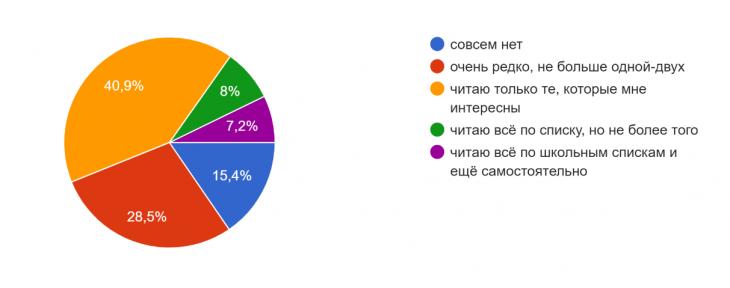
Diagram No. 4 The analysis of the results confirms the low level of confidence in the teacher's literary taste. Of course, the fact that children prefer only books that are interesting to them is not critical in the context of talking about additional, recommended literature, but it leads to disappointing conclusions. For the most part, students do not even make an attempt to learn more about a particular work that is not included in the list of interesting books known to them in absentia or suitable for genre preferences. This once again brings us back to the tasks of forming a stable motivation of students to read and returning one of the leading positions to the teacher in this process. The thirteenth question – "How do you learn about new or interesting books?" – deepens the researchers' understanding of the interest and motivation of children to read, gives access to the establishment of new communicative relationships with the reading environment both inside the classroom (children – reading environment – teacher) and outside the walls of the educational institution (teacher – teaching staff – library – parents – children). 
Diagram No. 5 The survey yielded the following results: the overwhelming majority of respondents, 362 people (72.5%), learn about books from the Internet, 218 (43.7%) — from friends, a considerable proportion of respondents — 144 people (28.9%) — get information about books in specialized stores. The fourth most popular option is "from the teacher /in the school library" — it was chosen by 142 respondents (28.5%). 101 students (20.2%) learn about books from their parents, and 56 students (11.2%) are not interested in new books at all. It is necessary to note the high frequency of choosing the third answer to the question ("on the Internet"). This option provides the basis for specific methodological actions for the authors of the article for further research. When forming a reading environment, it is important to pay attention to competent and safe Internet resources and promote them among students, as well as create your own literary topic and your own reading space in social networks.
The fact that almost 44% of students discuss books with their peers and trust their opinion gives grounds for predicting a multiple increase in motivation to read among schoolchildren, provided that a reading environment is created in a particular educational institution or classroom. By exchanging opinions and sharing their impressions, students can "charge" all their friends and acquaintances with a positive attitude to reading. This aspect will be one of the key ones in the subsequent evaluation of the effectiveness of the reading environment. An alarming fact for us was that the teacher, parents and the school library do not occupy leading positions in the process of educating the love of reading among schoolchildren. These negative trends are designed to correct the reading environment, one of the functions of which will be interdisciplinary and intersubjective cooperation in the process of forming a stable internal motivation of students to read. The last, fourteenth question – "Which source is more convenient for you to perceive for obtaining information?" – firstly, allows you to state or refute the results of the sixth and seventh questions, clarify and deepen them, and secondly, it is aimed at clarifying and clarifying the elements of the reading environment, its type, functional, structural and structural features. 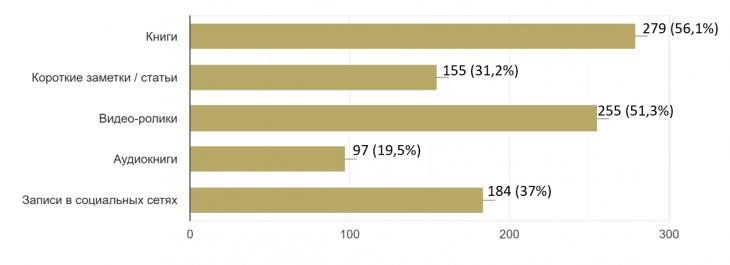
Diagram No. 6 It was found that books are the most convenient source of information – they were chosen by 279 respondents (56.1%). 255 students (51.3%) noted "videos" as one of the most convenient options, and "social media posts" (184 students or 37%) took the third most popular place. The format of short notes and articles is convenient for 155 students (31.2%), and audiobooks were the least convenient — only 97 students (19.5%) chose them. Based on the questionnaire, several very important conclusions can be drawn. Firstly, children like to read, but they do it quite rarely — either once a week or less often. The situation is also aggravated by the fact that, even having the opportunity to read, children can hardly stand more than 1-1.5 hours for a book. Mass literature of the most common genres is mostly in favor for students: science fiction, fantasy, detective, adventure prose and horror. And mass literature, unfortunately, displaces classical works. Secondly, as for the reading culture and the level of motivation of children to read in the educational process, the conclusions are even more disappointing. Despite the fact that 36.5% of respondents (182 people) prefer reading the full author's text, the rest (overwhelming) of schoolchildren study works either in adapted expositions or in the format of a summary. Thirdly, the importance of the Internet in general and social networks in particular greatly affects the role of literature in the life of the younger generation. They not only become the main sources of new information, but also are one of the key mechanisms for finding new books and forming motivation to read. Fourth, the problem of respondents' sincerity was revealed [9, p. 26]. The analysis of all the questionnaires makes it possible to say that about 6% of the students were insincere in their answers (the discrepancy between the choice of "yes" when asked "Do you like to read" and the complete absence of favorite books, favorite genres, time to read, desire to read, as well as interest in finding new works). Conducting this survey made it possible to study the problem of children's and adolescent reading, as well as the problems of reading culture and motivation to read based on data collected on the territory of the Ulyanovsk region. Most of the conclusions drawn on the basis of the questionnaire will be used in the formation of elements of the reading environment. The next step of the authors of the article will be to conduct a second questionnaire, more open in its format and more similar to interviewing. A number of open—ended questions will be aimed at finding out the reasons for the lack of motivation to read and, conversely, at finding out the reasons that form children's desire to read fiction.
References
1. Armstrong M.Practice of Human Resources Management / translated from English, ed. by S.K. Mordovin. SPb., 2009. 831 p.
2. Vinogradova G.G. Social orientation and reading of teenagers of 11-15 years // Children's reading at the turn of the century: Problems. Studies. Predictions : a collection of scientific papers. Ì., 2001. p. 63¬66.
3. Voyushina M.P. Methodological ways of solving social problems // Culture of reading in the context of modernization of the Russian school: Materials of the Second Scientific and Practical Conference. January 25, 2003. SPb., 2003. p. 11¬13.
4. Vygotsky L.S. Collected Works: in 6 volumes. Ò. 4. Problems of child (age) psychology. Ì., 1984. 432 p.
5. Galaktionova T.G. Reading schoolchildren as a socio-pedagogical phenomenon Open education: the problems of research // Proceedings of the Russian State Pedagogical University. Herzen State Pedagogical University: scientific journal. SPb., 2003. ¹ 6 (14). p. 177¬190.
6. Dostoevsky F.M. Crime and Punishment: summary of the novel. [Electronic resource]. URL: https://briefly.ru/dostoevsky/prestuplenie/ (date. 15.12.2021).
7. Malakhova N.G. "I read because I like to read a little bit".About the motives Readings of teenagers // Homo legens-The man reading. Ì., 2006. p. 241-251.
8. Melentieva Y. P. Reading electronic publications as an element of training and Education. // Scientific and technical libraries. 2019. ¹ 4. Ñ.76¬83 [Electronic resource]. URL: https://elibrary.ru/item.asp?id=37244793 (date. circulation 15.12.2021).
9. Myagkov A.Y. Sincerity of respondents: a conceptual analysis.// Vestnik. Tambov University. Series: Humanities. 2004. Vol. 3 (35) p. 22¬29.
10. Salomadin I. A. Methodology of the formation of the reading environment at school on The example of the study of the concept "nature" in the poem of I. Brodsky "Zofia" //. Innovations and developments in the sphere of humanitarian and socio-economic sciences. The article is a collection of scientific papers on the materials of the International scientific-practical conference. June 30, 2021. Belgorod, 2021. Ñ. 71¬79.URL: https://apni.ru/article/2652-metodika-formirovaniya-chitatelskoj-sredi (date of accessed 15.12.2021).
11. Trufanova E.O. Escapism and escapist consciousness: to the definition of concepts//. Philosophy and culture. 2012. ¹ 3. Ñ. 96¬107
Peer Review
Peer reviewers' evaluations remain confidential and are not disclosed to the public. Only external reviews, authorized for publication by the article's author(s), are made public. Typically, these final reviews are conducted after the manuscript's revision. Adhering to our double-blind review policy, the reviewer's identity is kept confidential.
The list of publisher reviewers can be found here.
The subject of the research in the article "Questioning the reading interests of middle and high school students in the Ulyanovsk region as an effective tool for the formation of motivation to read" is the identification of reading motives among students in grades 5-11 of secondary school. The article raises an urgent problem – the formation of the reading culture of schoolchildren. According to the results of the survey, possible directions for creating the education of younger schoolchildren are indicated. The methodology of the work is based on empirical methods: questionnaires and mathematical processing of research results. The purpose of the survey is to determine the needs of schoolchildren in reading, to identify their motivation to read and the level of reading literacy. 499 students from urban and rural schools of the Ulyanovsk region took part in the survey. It should be noted that, in methodological terms, the study was conducted correctly, the statistical data are new and can serve as a basis for scientific reflection and the formulation of scientifically sound conclusions. The article is written in scientific language. The introduction describes the problem field of research and formulates its tasks. The main part of the article describes the methodology of the questions presented in the questionnaire and discusses the empirical results obtained. The authors describe the substantive aspects of the study in sufficient detail and in detail. It is noted that his research results are aimed at "clarifying and clarifying the elements of the reading environment, its type, functional, structural and structural features." The results of the empirical study are accompanied by diagrams. The authors try to interpret the data obtained in sufficient detail, comparing them with the sources available in the scientific literature. At the end of the article, there are conclusions that are structured and indicate that the survey is aimed at studying the problem of children's and adolescent reading, as well as the problems of reading culture and motivation to read. According to the authors, a promising direction is the development of components of the reading environment. The results of the scientific novelty of the article should include the problems of the formation of students' reading culture identified during the survey (time allotted for reading, genre preferences of schoolchildren, children's motives for reading in the educational process, the ability to read the full author's text, the role of the Internet and social networks in the formation of reading preferences of the younger generation, as well as the formation of motivation to read. The issues of forming a reading environment based on interdisciplinary and intersubjective cooperation deserve attention. The environment can be an important condition for the formation of stable internal motivation of students to read. The bibliography presented in the article contains 11 sources that correspond to the subject of the study. Among them there are scientific articles and methodological materials. The list of references is designed according to GOST and there are references to sources in the text. There are some stylistic errors (e.g., "age correlation was detected"). Meanwhile, the material presented in the article may be of interest to teachers and researchers involved in the formation of the reading culture of adolescents.
|
















 This work is licensed under a Creative Commons Attribution-NonCommercial 4.0 International License.
This work is licensed under a Creative Commons Attribution-NonCommercial 4.0 International License.

 Eng
Eng


